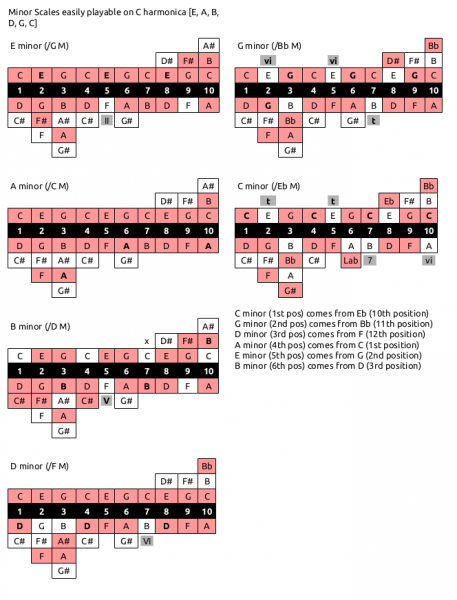Song in E minor
there is a tune I would like to play along with and its in E minor. Just wondering the correct key to play in second position?
I did a little computer program in order to find out the easiest scales played on a major diatonic C harp (i.e. with easy to bend note and as few as possible notes missing, note wise not chord wise).
Below is the table of the natural minor scales easily played on a C harp (two columns, top left is the easiest, bottom right the hardest among the easiest).
If you are looking for another minor scale, stop reading as the following might not apply.
The pink notes belong to the scale, the white don't. The missing notes are greyed(II for major second, ii for minor second, t for minor third and so on). The bold note is the tonic.
In your case, we are lucky as the table shows that the easiest minor scale is played on a C harp. E minor is the natural minor scale of G major which is the second position of C.
If you want to play in minor in second position, the table shows that it would be in G minor on a C harp. E is 1.5 tones below G, so if you want to play E minor in second position then that would be on a A harp (C - 1.5 tones).
Note that the following tables are for individual notes, not for chords.
For chords, you can refer to the answer of Winslow.
If you are interested in chords you can also buy yourself a E minor harp and discover the joy of exploring another tuning.

If you find a mistake in these tables please tell me.


You can use several key positions to may a minor-key song.
That said, several different "flavors" of minor scale exist, so without knowing which flavor, I can't smake a specific recommendation.
However, I can give a rundown of some possibilities.
There's one note in the scale that makes a scale (and a song) minor: the third degree. For instance, in C, if you count up 1-2-3 or C-D-E, E is the third degree. E natural is a major third, while E-flat is the minor third. But the 6th and 7th degrees can also be major or minor, and some minor tunes will minor-ize those degrees as well.
If these concepts are unfamiliar, don't worry.
There are three positions that by default give you some type of minor scale.
Perhaps the best thing you can do is try playing each of these positions against a minor song and see which sound seems to fit best.
Here's a bit more detail:
Third position gives you a minor chord in Draw 4-5-6 and 8-9-10, with the key note residing in Draw 1, 4, and 8. It has a minor 7th but a major 6th (Draw 3 and 7), which makes it sound sort of exotic but may not fit some minor songs. So, depending on the tune, those notes might be avoid notes (though you can bend Draw 3 down to make it minor). You can also bend Draw 1 and 4 down if you need the major 7th note in the scale.
Fourth position gives you a pure "natural minor" scale - third, sixth, and seventh are minor. Great if that's the scale of the tune. But you don't get a full chord. The keynote is Draw 6, but the other chord notes are Blow 1/2, 4/5, 7/8 and 10. Also, you have to bend Draw 3 down 2 semitones to get the key note in the low register, which can be tricky to get in tune and to sustain. But if you do your main melody work in Hole 4 and above, it can sound great. (Also, you can bend Draw 6 down if you need the major 7th degree, whcih some minor tunes use.)
Fifth position is used sometimes and has some cool possibilities. The key notes are in Blow 2, 5, and 8, and the note one hole to the right is a chord note. Bending Draw 2 slightly and Draw 3 create some great sounds. However, Draw 5 and 9 are sour-sounding avoid notes unless you're doing some sort of Spanish Flamenco or maybe middle eastern thing where the second degree of the scale is also minor.